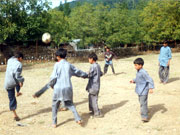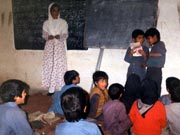
The Kashmir conflict, which killed at least 35,000 people since 1989, has sired a generation of children lost to hate and fear. They grow up in the no man's land between politics and war. This series focuses on them, the children of an unfortunate conflict.
By CHINDU SREEDHARAN
|
• About This Series • Page 1 • Page 2 • Page 3 • Page 4 • Page 5 • Page 6 • Page 7 • Page 8 • Page 9 • Page 10 
Related Specials • 'I don't need tests to identify my son' • Blood in the snow • A soldier's story • This is Kashmir! • Children of Kashmir • Valley of darkness More |
[You are on page 8 of this series. Read the previous page.]
The first to go were the school buildings.
This ignited a fiery phenomenon across the land: militants burnt down schools to deny troops shelter. They also attacked and damaged, where they could, the security forces' newfound bases. The combined result was that many schools were destroyed and many others taken over by security forces, who were to stay put for years. Even as this was playing out, education in Kashmir registered its second hit. The exodus of Hindu Pandits, which started in 1990, saw over 30,000 schoolteachers leaving the valley. "Overnight, I lost 50 of my best," recalled Dr Parwez Samuel Kaul, principal of the 120-year-old Tyndale Biscoe Memorial School in Srinagar. "The Pandits were traditionally teachers, the best we had. When they migrated, they left a huge vacuum that took years to fill." A senior intelligence official who has done multiple stints in the valley sees another fallout in the Pandits' migration -- the destruction of secular education. In fact, he feels this was the major reason why 'Pakistan sponsored the terrorisation of Hindus' and 'deliberately burnt down school buildings.' "You see, 80 to 90 per cent of schoolteachers were Pandits," he said. "They inculcated secular values in Muslim children, they spoke about India and what it stood for. From Pakistan's point of view that was dangerous. What they wanted was jihadi teachings, the kind that would adapt children for separatist indoctrination." Lieutenant General Arjun Ray, an avid Kashmir watcher who was once part of the Indian Army's 15 Corps in Srinagar, which is responsible for counterinsurgency in the valley, elaborates on this in his book Kashmir Diary. 'As part of a deliberate policy to drive children away from liberal education, militants, with the tacit approval of the Jamaat-e-Islami, 20 have torched 375 government-run schools (176 primary, 128 middle and 71 higher secondary),' he wrote. 'At the same time, and surely not by chance, the madrasas have been reinforced by a substantial increase in the number of Jamaat-run schools as well as scholarships.' The turbulent years also saw the dropout rate climbing, according to Professor Madhosh, 'at least 20 per cent.' Many students exchanged their textbooks for AK-47s, and many more started working because militancy preyed on their family's fragile finances. For instance, sociologists report that a number of children became daily labourers21 in Kashmir's carpet industry as they lost their breadwinner in militancy-related incidents. Compounding all this was the psychological stress the turbulence brought about. The ever-present feeling of uncertainty, danger and anxiety, psychologists say, discouraged learning through loss of memory, lack of concentration, and insubordination. One indicator of this trend, says Dr Wahid Khan, a leading psychiatrist in Srinagar, was the 'increased' number of students who have blacked out during examinations. "For their minds stressed to the brink, the additional tension of an exam was too much to cope with," he explained. "So their minds switched off, temporarily." Even the Pandits, though now removed from the turmoil, continue to be affected. Their homeless status, and crammed living conditions (the majority are put up in migrant camps in Jammu, in one-room tenements, with very basic necessities) are greatly stressful, feeding on their minds. "All their competence have gone out of their minds," said Professor Madhosh. "Eighty per cent of them don't feel normal in Jammu. So they are not doing as well as they should." It's a reasonably happy picture the Jammu and Kashmir government paints of its educational system today. Education Secretary Vijaya Bakaya encapsulates it thus: 15,500 institutions, 90,000 teachers and 18 lakh [1.8 million] students; and against the 600,000-odd children not attending schools there is double that number in schools. Independent observers, however, dismiss this as statistics that are good for political consumption but translate to very little on the ground. Yes, they say, there are possibly that many institutions, and that many teachers, and that many students -- but what about other infrastructure, what about the quality of teachers, what about the opportunities of learning the students get? "Most of the rural schools are understaffed, in some cases there are not even buildings," said a schoolteacher, who wished anonymity. "Where I work, we don't have enough maps or globes -- and no science laboratory, though it is supposed to be a high school. This is true of most schools in rural Kashmir." The high school in Lolab, in the militancy-infested border district of Kupwara, appears to be a classic case in point. Adjoining it is a small, sandbagged, fenced security force camp, manned by tense troops. You need their grudging permission to pass through into the school area. Inside, in one of the two resurrected structures (the old building had been burnt down in the early 1990s), the teachers, over cups of salted tea, pour out their miseries bit by bit: till recently, there used to have classes under the open sky; there are six teaching posts lying vacant; there are laboratory assistants (but no laboratory anymore) filling in for the yet-to-be-posted teachers; no officials have come for inspection for 'as long as we can remember'; no toilets... A casual walk around shows you there are no benches or desks, either. The children, most of them dressed like refugees, sit on the floor, their books in their lap.
In this cash-strapped state, funds -- or the lack of it -- are a major reason for the plight of government education, bureaucrats say. Eighty per cent of the state's Rs 1.6 billion educational budget, according to Bakaya, is spent on salaries alone. This includes pay for the 12,000-odd non-productive Pandit teachers living in migrant camps. "We need changes at policy level," said Professor Madhosh. "First, we need to improve the quality of teachers." Though the government managed to fill up the vacancies created by the Pandits' departure, the quality of staff has fallen drastically, he feels. "Even matriculates have become teachers now," he said. "When trained people were not willing to go to villages, the government was forced to appoint available talents in rural areas." As remedy, he offers refresher courses and orientation programmes for teachers, for the new appointees as well as the old. "Another aspect that needs to be tackled is the system of examination," he continued. "The current system is very vulnerable to turmoil." He proposes that public exams be given the minimum significance, that '80 per cent of marks come from a continued evaluation system by teachers'. "The public exams would only to confirm the other markings," he said. "There should also be complete transparency in the system of valuation. This will make malpractices difficult." Professor Madhosh also recommends the revival of extra- and co-curricular activities, which had come to a grinding halt since 1990 and which, according to a senior bureaucrat, is not22 'a priority now.' "The academics are picking up, but not other co-curricular activities," said Professor Madhosh. "That's most disastrous because academics contribute only 30 per cent of a child's education." Divisional Commissioner Khurshid Ganai, the administrator in charge of the Kashmir province,23 too, is bothered about the standard of education in the valley. After 1994, Kashmir saw private educational institutions mushrooming; but these, Ganai feels, do not reach out to the majority of people. "The only way to ensure a decent life is education," he said. "If we make education in government schools qualitatively better, that will have a demonstration effect. It will provide good career, which in turn will wean away children from militancy and destruction." In fact, it is lack of quality education, educationists say, as much as the turmoil that has seen a steady stream of Kashmiri children packing their bags for schools and colleges in other parts of the country. "It is better they go out, study and get jobs than rot here." said Ganai. "Till opportunities develop here, we will have to live with that." Till opportunities develop. And when will that be? "Education is an activity of peace," Professor Madhosh said. "Not of turmoil." Page 9: We know the killers. We will kill them Return to the previous page.
This article is part of Chindu Sreedharan's study on the Impact of Militancy on the Children of Kashmir, as a National Foundation for India Fellow for 2000-2001. Page Design: Rajesh Karkera |
(c) 1996 - 2001 rediff.com India Limited. All Rights Reserved.

